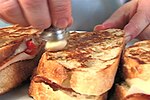Panini (sandwich): Difference between revisions
Forever Dusk (talk | contribs) m Reverted edits by 68.92.151.100 (talk) to last revision by 83.100.203.6 (HG) |
|||
| Line 23: | Line 23: | ||
==See also== |
==See also== |
||
*[[Sandwich toaster]] |
*[[Sandwich toaster]] |
||
*[[Croque-monsieur]] |
*[[Croque-monsieur]]and the unicorn flew over the rainbow |
||
*[[Grilled cheese sandwich]] |
*[[Grilled cheese sandwich]] |
||
*[[Submarine sandwich]] |
*[[Submarine sandwich]] |
||
Revision as of 17:09, 24 September 2010
This article needs additional citations for verification. (January 2010) |

Panini are sandwich-like food items, Italian in origin, but now international.
In Italy, a panino (Italian pronunciation: [paˈniːno]) is customarily made from a small roll or loaf of bread, typically a ciabatta or a rosetta. The loaf is cut horizontally and filled with salami, ham, cheese, mortadella or other food, and sometimes served hot after having been pressed in a grill. A toasted panino, colloquially called "toast" by Italians, is made out of two vertical slices of pane in cassetta almost invariably filled with prosciutto and a few slices of cheese, grilled in a sandwich press. In Central Italy, there is a popular version of panino which is filled with porchetta, i.e. slices of roasted pork. It is traditionally served without any kind of sauce or topping.
Some maintain they are the same as 'toasties' but with a different shape.
Terminology
The word panino [pa'ni:no] is Italian for "small bread roll"; its plural form is panini. The word is the diminutive form of pane ("bread"). Outside Italy, panini is often used as a singular word (like salami, also an Italian plural noun) and sometimes pluralized as paninis.
In Italian, panino refers properly to a bread roll and a panino imbottito (literally "stuffed panino") to a sandwich. A paninoteca is a humorously inflated word for a sandwich bar.

History
Although the first U.S. reference to panini dates to 1956, and a precursor appeared in a 16th-century Italian cookbook, the sandwiches became trendy in Milanese bars, called paninoteche, in the 1970s and 1980s. Trendy U.S. restaurants, particularly in New York, began selling panini, whose popularity then spread to other U.S. cities, each producing distinctive variations of it.[1]
During the 1980s, the term paninaro (slang for a maker and seller of panini, or his shop), was extended to its patrons as well. It was used to denote a youngsters' culture typical of teenagers supposed to eat and meet in sandwich bars such as Milan's Al Panino and then in the first US-style fast food opened in Italy. Paninari were depicted as fashion-fixated, vain individuals, delighting in showcasing early 1980s status symbols such as Timberland shoes, Moncler accessories, Ray-Ban sunglasses and articles from Armani, Coveri, Controvento. So they were lampooned in the Italia 1 comedy show Drive-in by Enzo Braschi. A track entitled "Paninaro" appears on Pet Shop Boys' albums Disco and Alternative.
See also
- Sandwich toaster
- Croque-monsieurand the unicorn flew over the rainbow
- Grilled cheese sandwich
- Submarine sandwich
References
- ^ Zeldes, Leah A. (October 28, 2009). "Eat this! Panini, Italy's answer to grilled cheese". Dining Chicago. Chicago's Restaurant & Entertainment Guide, Inc. Retrieved October 30, 2009.
